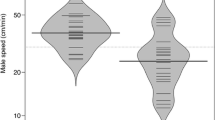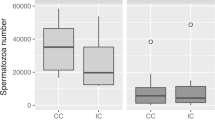Summary
The Japanese calopterygid damselfly Mnais pruinosa pruinosa shows three distinct copulation durations (Siva-Jothy and Tsubaki 1989). A variety of factors which might influence copulation duration were investigated. Results indicate that the temperature in the vicinity of copulating pairs, the rate at which males encountered receptive females, territory quality, the rate of agonistic interactions between males, female gravidity and female ‘willingness’ to oviposit have no effect on copulation duration. The most significant factor was the location of the site at which males captured their mates. We suggest that under natural conditions the location of the capture site provides males with reliable, indirect information about a female's intention to oviposit: it is important for males of this species to acquire such information since sperm precedence, and therefore reproductive success, is in part dependant on the interval experienced by females between copulation and subsequent oviposition. The results are discussed and it is suggested that the three observed mate-securing tactics of M.p. pruinosa are facultative and information-dependant.
Similar content being viewed by others
References
Corbet P (1962) A Biology of Dragonflies. Witherby, London
Dickinson JL (1986) Prolonged mating in the milkweed leaf beetle (Labidomera clivicollis clivicollis, Coleoptera: Chrysomelidae): a test of the sperm loading hypothesis. Behav Ecol Sociobiol 18:331–338
Dickinson JL (1988) Determinants of paternity in the milkweed leaf beetle. Behav Ecol Sociobiol 23:9–19
Miller PL (1981) Functional morphology of the penis of Celithemis eponina. Odonatologica 10:293–301
Miller PL (1982) Genital structure, sperm competition and reproductive behaviour in some African libellulid dragonflies. Adv Odonatol 1:175–192
Miller PL (1983) The duration of copulation correlates with other aspects of mating behaviour in Orthetrum chrysostigma (Burmeister) (Anisoptera: Libellulidae). Odonatologica 12:227–238
Miller PL (1984) The structure of the genitalia and the volumes of sperm stored in male and female Nesciothemis farinosa (Forester) and Orthetrum chrysostigma (Burmeister) (Anisoptera: Libellulidae). Odonatologica 13:415–429
Miller PL (1987) An examination of the prolonged copulations of Ischnura elegans (Vander Linden) (Zygoptera: Coenagrionidae). Odonatologica 16:37–56
McLain DK (1980) Female choice and the adaptive significance of prolonged copulation in Nezara viridula (Hemiptera: Pentatomidae). Psyche 87:325–336
Parker GA (1970a) Sperm competition and its evolutionary effect on copula duration in the fly Scatophaga stercoraria. J Insect Physiol 16:1301–1328
Parker GA (1970b) The reproductive behaviour and the nature of sexual selection in Scatophaga stercoraria L. (Diptera: Scatophagidae). II. The fertilization rate and the spatial and temporal relationships of each sex around the site of mating and oviposition. J Animal Ecol 39:205–228
Pfau HK (1970) Struktur und Funktion des sekundären Kopulationsapparates der odonaten, ihre Wandlung in der Stammesgeschichte und Bedeutung für die adaptive Entfaltung der Ordnung. Z Morphol Tiere 70:281–371
Rutowski RL, Alcock J (1980) Temporal variation in male copulatory behaviour in the solitary bee Nomadopsis puellae (Hymenoptera: Andrenidae). Behaviour 73:175–188
Sillén-Tullberg B (1981) Prolonged copulation: a male “postcopulatory” strategy in a promiscuous species, Lygaeus equestris (Heteroptera: Lygaeidae). Behav Ecol Sociobiol 3:203–243
Siva-Jothy MT (1987) Variation in copulation duration and the resultant degree of sperm removal in Orthetrum cancellatum (L.) (Libellulidae: Odonata). Behav Ecol Sociobiol 20:147–151
Siva-Jothy MT, Tsubaki Y (1989) Variation in copulation duration in Mnais pruinosa pruinosa Selys (Odonata: Calopterygidae). 1. Alternative mate-securing tactics and sperm precedence. Behav Ecol Sociobiol 24:39–45
Thornhill R (1980) Sexual selection in the black-tipped hangfly. Sci Am 242:162–172
Waage JK (1979) Dual function of the damselfly penis: sperm removal and transfer. Science 203:916–918
Waage JK (1986) Evidence for widespread sperm displacement ability amongst Zygoptera and the means for predicting its presence. Biol J Linn Soc 28:285–300
Author information
Authors and Affiliations
Rights and permissions
About this article
Cite this article
Siva-Jothy, M.T., Tsubaki, Y. Variation in copulation duration in Mnais pruinosa pruinosa Selys (Odonata: Calopterygidae). Behav Ecol Sociobiol 25, 261–267 (1989). https://doi.org/10.1007/BF00300052
Received:
Accepted:
Issue Date:
DOI: https://doi.org/10.1007/BF00300052




